If you saw the movie “The Hundred-Foot Journey,” you may have been enthralled by the story of a young immigrant chef’s rise from obscurity to culinary stardom in France, of all places. The journey referred to the distance from the chef’s family-owned Indian restaurant to the Michelin-starred French restaurant across the street. As someone who loves food and enjoys cooking, the real star of the movie was the cabinet of spices that once belonged to the star’s mother. I didn’t have a clue as to what they were, or how I would use them, but I wanted to know more.
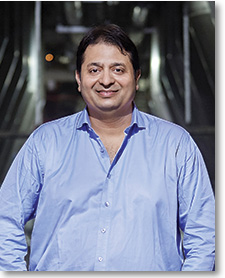 Everest, Rajiv Shah’s family-owned business in Mumbai, has been manufacturing and blending spices for more than 50 years. Today, the company’s flagship Everest is India’s best-selling spice brand. When it decided to open a new factory in Umbergaon, Gujarat, in November 2016, the company made its own journey from a completely manual to highly automated materials handling processes.
Everest, Rajiv Shah’s family-owned business in Mumbai, has been manufacturing and blending spices for more than 50 years. Today, the company’s flagship Everest is India’s best-selling spice brand. When it decided to open a new factory in Umbergaon, Gujarat, in November 2016, the company made its own journey from a completely manual to highly automated materials handling processes.
The facility features two automated storage and retrieval systems (AS/RS; Daifuku). One, designated for raw materials, has three storage and retrieval cranes and 2,160 pal-let locations for the storage of 1,200 metric tons or enough for three days of production. Reaching more than 80 feet high, the raw materials AS/RS manages 60 different raw materials on a strict first-in/first-out basis. The other, designated for finished goods storage, also has three storage-retrieval (S/R) cranes and 4,464 pallet locations. The finished goods AS/RS is serviced by a sorting transfer vehicle (STV) system, which moves pallets from the packing area to the AS/RS induction area.
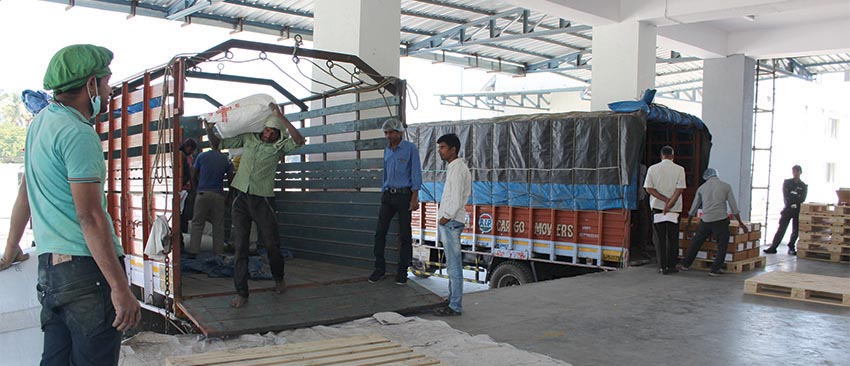
Raw materials are manually unloaded and palletized. Pallet sizes are unique to a facility.
“This is the world’s largest spice processing factory,” says Rajiv, who adds that he wanted a system that would allow him to:
- handle three times the amount of material he handles in his existing factory on a daily basis plus room for buffer materials;
- increase the productivity of employees, while reducing their burden; and
- improve inventory control and accuracy.
“The biggest improvement from automation has been in productivity, which has increased four fold,” he says. “In our factory in Mumbai, without the AS/RS the productivity is roughly about 160 units per day per person. In the new plant, the productivity has gone up to 600 units per day.”
Spice in the business
According to Rajiv, his family, including his father and grandfather, have been in the spice business for decades, initially selling spices and dry fruits from a retail store. Based on customer request and adapting to the changing needs of the society, Everest started processing ready-to-use blended spice mixes. “We started with just a few products in 1965 and later on expanded from there,” Rajiv says.
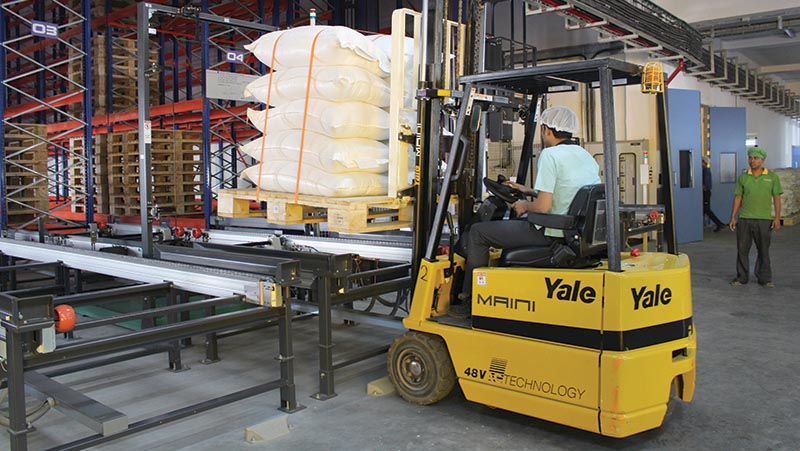
Today, the company dominates the spice business in India, with close to a 31% market share. It’s the only brand with nationwide distribution. The company produces 45 products under the Everest brand, available in 200 different sizes and serves a network of 600,000 shops that are visited on a weekly basis by a representative from Everest. Orders are filled at the full case level, and are later redistributed in smaller quantities.
Automation in India
The story of Everest’s embrace of automation is the first of three system reports we plan to run this year in Modern that focus on materials handling best practices outside of North America.
In each, we want to not just focus on the company at hand, but take a deeper look into some of the trends impacting industrial production and distribution in each of the countries we feature. Think of it as the “National Geographic” approach to global materials handling.
Our tour guide to India is Asim Behera. Based in Mumbai, Behera is the chief operating officer and board member for Daifuku India Private Limited. He moved back to India in 2011, after having spent time working in the United States for another global systems integrator. Back then, there wasn’t much interest in automation.
“It was easy to get cheap labor, land was not expensive, and there weren’t a lot of takers for systems like the one we installed at Everest,” he says. “The human conveyor was still the cheapest form of conveyor.”
Such was the lack of interest that he considered moving back to North America in 2013.
Since that time, things have changed. In the last three years, Daifuku has installed 17 automated storage/retrieval systems (AS/RS) in India. What changed? In some respects, India is grappling with challenges that are familiar to U.S. operators.
For starters, cheap labor is turning out to not be so cheap because the skill sets required in contemporary distribution aren’t readily available. “Nobody wants to work in a warehouse when they can move to a growing metropolis and work as a security guard in an air conditioned mall for the same pay as working in a warehouse,” Behera says.
The growth of urban areas also means that land is no longer cheap. Instead, factory and warehouse operators are looking to build up—not out—to reduce their footprints, which creates an opportunity for automation, especially for solutions like AS/RS that take advantage of the full cube of a building.
A third change is that many business owners, like Rajiv, are second- and third-generation professionals who are looking to take their businesses to the next level. They have traveled extensively, had the chance to see automated factories and distribution systems in Europe and North America and are now asking how those solutions can be applied in their operations.
“The business owners are visionaries,” Behera says. “They may only have selective racking now, but they want to go right to automation so they can reduce dependencies.”
He adds that most factories have installed high-end production systems from Germany and Italy. The next step is to automate their storage, picking and shipping processes.
Still, there are challenges. Loading and unloading is still largely manual since pallets are only used internally. That’s because shippers floor load as much product as they can in a trailer to off-set the high cost of transportation. As a result, there’s no standard pallet, like the 48 x 40-inch pallet used in North America or the Euro-pallet used in Europe.
“Every project design starts with the pallet used inside the factory, and every factory uses its own pallet,” says Behera.
India has also been slow to adopt automated piece picking technologies, such as shuttles and mobile collaborative robots, and automated transportation such as automatic guided vehicles, even though Indian solution providers are jumping into that market. “You don’t have mega e-commerce fulfillment centers in India like you have in the United States, so they’re not investing in that kind of automation yet,” says Behera.
The distribution network sounds a little like the network for distributing a product like Avon. At the corporate level, there are 1,200 sales representatives who work with 60 super agents. They in turn supply product to the 2,800 agents who service retail customers on a weekly basis. “The whole channel reports to us,” Rajiv says.
For years, the spice industry in India was viewed as a something you would make at home or in a small scale and not a real industry. “The perception was that most people making spices had a small scale setup of a manual grinder and blender,” he says. “There was no automation.” Even today, he adds, more than half of his competition still operates like that.
The change for his business was the result of a push to market the products beyond the home base and the construction of the first factory in 1980, followed by other facilities, like a corporate office and packing locations. “Everything is located within about 5 miles of my house, which meant I could go to the office or the factory every day,” he says.
In 2009, he built his first highly automated production line, with a batching system from Germany. “To make spice, you might be blending 15 or 20 things together and then telling your people to grind it and pack it,” he says. “When we were making 10 tons a day, I could come in and tell our people how to do it. But, we designed the new factory for 125 tons a day. We needed a system that would allow the production manager to enter the blend he requires into the computer and the batching-grinding system would do the rest.” They found machines in Germany and India that process a batch of 2,000 kilograms of spice in less than 60 minutes.
Still, materials handling processes, such as storing and transporting raw materials and finished goods, was all done manually with a sizeable team on the shipping and receiving dock.
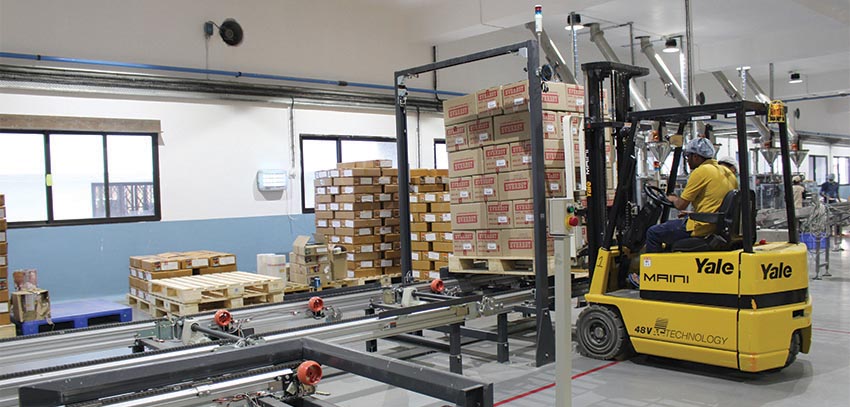
Automating storage
The catalysts for materials handling automation came in 2015, as S.narendrakumar & Co. began plans for a new factory. A lack of industrial land in Mumbai meant looking outside that 5-mile radius from the corporate headquarters.
“When we built the first factory in 1980, this was an industrial area,” says Rajiv. “Today, it’s the center of Mumbai, with shopping malls, business parks and condominiums where there used to be factories. Land is very expensive.”
Instead, the company purchased land in an industrial city about 100 miles from the corporate headquarters. That would mean less hands-on corporate oversight in what was going to be the largest spice factory in the world, capable of producing 400 metric tons of product a day, or more than three times what was being produced in the original Mumbai factory. That led to a new look at automation.
“From a production standpoint, we could just tell our suppliers in Germany to make a bigger and faster system, and we knew that we already had the best packing equipment,” Rajiv says. “But, if we’re going to make 400 tons a day, we have to handle 400 tons a day.”
What’s more, he adds, he didn’t want to operate the factory in a just-in-time fashion but instead, wanted storage space for 1,200 tons of raw materials as a buffer along with space for the storage of finished goods. And, he wanted to maximize productivity.
Continuing to operate manually at that scale would also have resulted in a significantly larger facility, requiring even more land, or multiple levels serviced by freight elevators. During a trip to Germany, Rajiv and his team saw an automated storage and retrieval system. “We thought we would look into this and see how it can make life better,” he says.
The new factory solution featured a two-level production area flanked on either side by automated storage and retrieval systems that reach just more than 80 feet tall. The ground floor level is reserved for receiving and palletizing raw materials, inducting them into the raw materials AS/RS, retrieving pallets from the finished goods AS/RS and loading orders onto trucks.
Production and packaging takes place on the second level, where pallets are retrieved from the raw materials AS/RS and staged for blending and processing. A sorting transfer vehicle (STV) system transports pallets from packaging to the second-level induction area for the finished goods AS/RS. That machine also stores packaging materials and empty pallets.
Rajiv says there was a learning curve. The biggest issue? Maintaining the system.
“One of our worries was what happens if the system breaks down since you can’t climb 80 feet and fetch something,” he says.
The apprehension to something so unknown that literally is a closed system was paramount. The solution provider was able to reduce anxiety by providing 24/7 on-site support after the hand over.
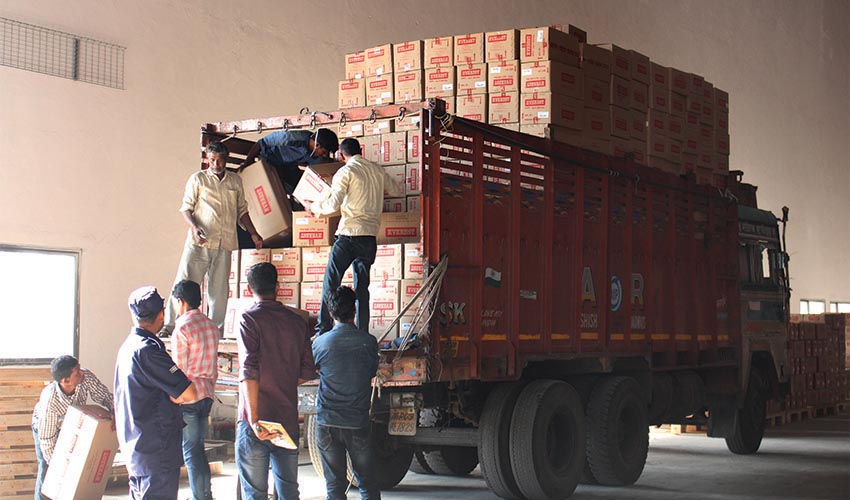
Pallets of finished goods are retrieved by the AS/RS (top) and delivered to a staging area. From there, orders are manually loaded onto outbound trucks (bottom). In India, almost all shipments are floor loaded.
Now that he has been working with automation, Rajiv says the company is expanding the number of cranes in the Umbergaon, Gujarat, location and is also investigating how automation may benefit the Mumbai factory. In addition to the improvement in productivity, Rajiv says it’s easier to manage inventory on a strict first-in/first-out basis.
“The machine has access to all of the inventory,” he says. “In the past, if it was hard to get one bag, an associate might grab another of the same raw material.”
But the most important benefit might be that automation is positioning the company to operate at the new pace of business.
Our conventional way of operating was to say that if you order today, you’ll get it in seven days,” Rajiv says. “Now we say that if you order before 4:00, you’ll get it tomorrow. The system has enabled my team to do more. You press a few buttons and the machine will put the product you need in front of you. That’s the best thing.”
Get an inside look at the layout of the new facility here.
Article topics








